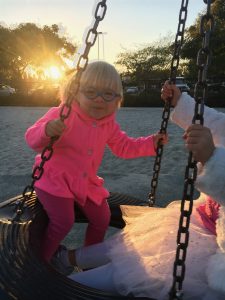Living with LCA: Juliet’s Story
Scott and Heather Soady and big sister Gillian welcomed baby Juliet two years ago, and life progressed in an understandably hectic way for the San Diego parents who also are practicing lawyers. But life soon became more complicated as the couple’s new baby was diagnosed with Leber congenital amaurosis.
Juliet was born with strabismus, also known as crossed eyes, a condition that often disappears with time. At the age of 4 months, Juliet’s pediatrician noticed she had involuntary eye movement, a condition called nystagmus. The doctor said Juliet presented the worst case she’d ever seen in a child.
Doctors placed Juliet under general anesthesia to scan her optic nerve and eliminate causes of her  condition. It was a difficult time, Scott said, for Heather, especially, because she was breastfeeding and Juliet was only 4 months old.
condition. It was a difficult time, Scott said, for Heather, especially, because she was breastfeeding and Juliet was only 4 months old.
When doctors told Scott, “It’s probably not brain cancer, ” he said, “I didn’t realize that was an option.”
Two months later, with Juliet again under anesthesia, a specialist measured her retina’s light perception by placing contact lenses with electrodes in her eyes. This procedure is called an Electroretinography (ERG) and is used to clinically diagnose LCA and other inherited retinal disorders such as Retinis Pigmentosa (RP), cone dystrophies, X-linked juvenile retinoschisis, achromatopsia and others.
Twenty minutes later, the family received a confirmed clinical diagnosis of Leber congenital amaurosis.
“What you’re told is, there’s this condition you’ve never heard of, that’s extremely rare, that has no cure, that’s she’s going to be blind and there is nothing you can do about it,” Scott said.
“… You go through this grieving process of the life that you envisioned for your child. I would constantly think about these things, going to the beach, seeing a sunset, watching a movie, doing all of these things with her and sharing the world with her, and all of a sudden, that’s never going to happen with her.”
Gradually, his perspective changed: “You’re still going to do all these things, but you’re going to do it in a different way. … There is nothing in the world that tells you what that’s going to be like for her. … You have to adapt everything so that it will happen.”
At the age of 2, Juliet is legally blind. With glasses, her vision is 20/470. In other words, Scott said, the same object and details you can see at 470 feet away, she will only be able to see at 20 feet. Doctors say her vision may deteriorate over time.
 Looking for more information and answers, Scott attended the national VISIONS conference hosted by the Foundation Fighting Blindness last summer in Baltimore.
Looking for more information and answers, Scott attended the national VISIONS conference hosted by the Foundation Fighting Blindness last summer in Baltimore.
“That’s where I met Laura (Manfre, Sofia Sees Hope co-founder) and a bunch of other families that have kids with the same condition. That was truly amazing,” Scott said. “You feel so alone, the condition is so rare, there’s not going to be someone you just run into.”
He said he was touched that for the first time, people asked how he was doing.
Meeting parents who are dealing with LCA and seeing young people with LCA functioning as normal teen-agers gave Scott comfort and hope that everything’s going to be OK.
Through Laura, Scott and Heather connected with Spark Therapeutics’ “ID your IRD” initiative for Juliet’s genetic testing. Scott said he still held hope that maybe Juliet really did not have LCA, but the genetic findings confirmed otherwise.
The testing also revealed that Juliet has what is called a de novo mutation of the CRX gene, which caused it to be autosomal dominant rather than autosomal recessive. This means Juliet’s condition is a result of a gene mutation, rather than from inheriting it from her parents. It also means that Juliet could pass it on to her children.
“It’s not quite the normal LCA,” Scott said. Of those who have LCA, 1 percent to 5 percent have this gene mutation.
Genetic therapy also is more complicated. Rather than inserting a good gene and having the bad one go away or bypassed, the CRX dominant gene first needs to be turned off before a good gene can be inserted
The Soadys connected with a doctor who was conducting this research but had to stop for lack of funding.
“The light at the end of the tunnel got much dimmer,” Scott said of the end of the research. “It would be nice to see if there’s a potential cure.”
For now, the family is in the intense process of preparing Juliet for a new time in her life, from a home environment to a school environment, as she begins preschool. Gillian, who turns 5 in September, will be in kindergarten.
